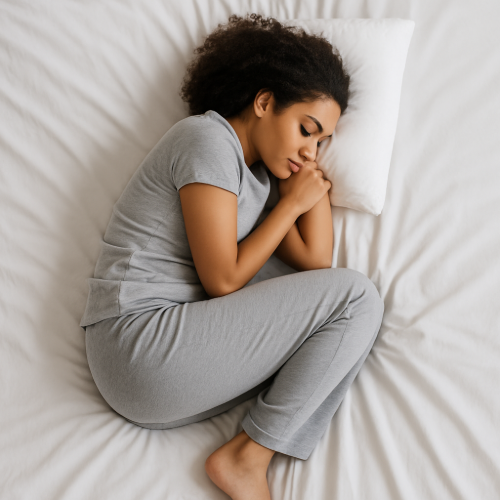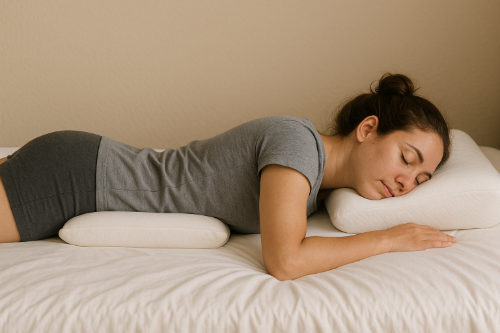5 Best Sleeping Positions For Lower Back Pain
Written by JaRoy Buffong

Lower back pain is frustrating, and if you’re dealing with it, you’re definitely not alone. Around 23% of adults worldwide experience chronic lower back pain (Casiano et al., 2022).
When it’s not addressed, back pain can make everyday life harder and limit your movement. It can also affect your sleep, which then impacts your focus, mental wellbeing and overall health (Alsaadi et al., 2010). So it’s important to take action.
5 Best Sleeping Positions for Lower Back Pain
See the top five sleep positions for lower back pain below:
1. Back Sleeping
Sleeping on your back is a great way to reduce lower and upper back pain.
When you lay on your back in a reclined position, your spine is straight and neutral. This ensures the vertera aren't strained or twisted, reducing the likelihood of aches or pains. You must keep your pelvis straight and your hips and shoulders aligned for the best results (www.urmc.rochester.edu, n.d.).
You can place a pillow underneath your knees if you want even more support. This takes the stress off your lower spine by keeping the natural curve in your lower back.
Pros:
- Reduces upper and lower back pain
- Keeps your spine supported
Cons:
- It can be challenging to adapt to this position after side sleeping
2. Side Sleeping
If you're a side sleeper, we have some good news. This is a healthy sleeping position — as long as you keep your back straight and switch sides occasionally to prevent imbalances.
When sleeping on your side, ensure your hips and shoulders are aligned and your neck straightened to prevent extra pain. Keeping your hips/pelvis straight should be the focus if you're experiencing lower back pain.
Pros:
- Ensures your back is straightened and aligned
- It is more comfortable than other sleeping positions
Cons:
- It can be difficult to keep the pelvis and hips straight without a pillow

3. Fetal Position
The fetal position is another popular side sleeping variant. This is because sleeping in a fetal position can also be helpful for herniated disks and general lower back pain.
A herniated disk happens when the jelly-like nucleus pushes against its outer ring due to injury or age, resulting in lower back pain (Park, 2020). A fetal position can give vertebrae extra space, leaving you with less pain.
To achieve this position, gently roll onto your side and tuck your knees towards your chest. Then, gently curl your torso to your knees. Keep your upper back straight, and avoid twisting your neck.
Pros:
- Great for general lower back pain and herniated discs
- The position is easy to achieve
Cons:
- Staying in a healthy fetal position throughout the night is difficult
4. Side Sleeping With Pillow
Another way to sleep on your side is with a pillow between your knees. Don't confuse this position with standard side sleeping, as the pillow does the trick. A pillow between your knees ensures your pelvis, hips, and spine are aligned all night.
If you embrace this position, make sure you routinely switch sides. Some studies suggest sleeping on one side can cause muscle imbalance and shoulder pain (Kempf and Kongsted, 2012).
Pros:
- Pillow between the legs adds extra comfort
- Sleeping with a pillow between the legs ensures the whole body is aligned
Cons:
- Sleeping on your side without switching can have adverse effects
5. Front With Pillow Under Stomach
Sleeping on your front isn't great for back pain, as it can add extra stress to your neck. However, if you naturally gravitate to stomach sleeping, you can make it more comfortable.
Place a pillow under your lower abdomen and pelvis to take excess pressure off your lower back. This way, there's less strain on your lower back, and you're less likely to twist your spine during the night. Keeping a pillow under your head is optional.
Pros:
- Pillow between the legs adds extra comfort
- Sleeping with a pillow between the legs ensures the whole body is aligned
Cons:
- Sleeping on your front doesn't support your neck and can cause neck pain
Bad sleep posture has been linked to back pain in daily life (Cary, Briffa and McKenna, 2019), so finding a position that protects your spine and lower back is critical.
But finding the best sleep posture for back pain isn't a one-size-fits-all decision. Multiple healthy sleep positions exist, and you should experiment with them to see what feels best.

Worst Sleeping Position For Lower Back Pain
There’s no one-size-fits-all answer, because any sleeping position can lead to pain if your spine isn’t properly supported.
That said, most experts agree that sleeping on your stomach tends to be the worst for back pain. It often forces your neck into an awkward angle and flattens the natural curve of your spine.
But if you’re a stomach sleeper, don’t stress. You can reduce the strain by keeping your spine aligned and using a sleep aid like a memory foam pillow to support your neck or hips. In some cases, this can actually help with lower back pain.
Shop Groove Neck Support PillowSleep Aids For Lower Back Pain
To ensure you're always putting your health first, consider investing in a memory foam mattress or ergonomic memory foam pillow. These tools improve your sleep posture, comfort, and spinal alignment due to their scientific design. Better sleep without the effort of monitoring your sleep position all night.
You can find orthopaedic memory foam pillows alongside traditional memory foam pillows designed to tackle lower back pain.
The Groove X Pillow was created to relieve fast-acting lower back pain with high-quality memory foam and a knee-supporting shape.
Memory foam mattresses can also improve lower back pain, as they're another way to take excess pressure and strain off your back.
When To Contact the Doctor
If you've been struggling with lower back pain for a while and have tried a range of sleeping positions, sleep aids, and other at-home solutions, it might be time to contact your local doctor.
Lower back pain, which persists for two to three weeks or worsens quickly, requires medical attention. Contact urgent care if you're experiencing sharp pain or have lost mobility.
See the Groove Pillow collection here.
Shop Groove PillowsAbout The Author
JaRoy Buffong is the founder and lead coach of Naiquan, a dynamic wellness company that empowers individuals to realize their full potential through a comprehensive 360° approach to well-being. With a deep understanding of the interconnectedness of physical, mental, and emotional health, JaRoy is committed to helping clients achieve sustainable, long-term transformations.
References
- Alsaadi, S.M., McAuley, J.H., Hush, J.M. and Maher, C.G. (2010). Prevalence of sleep disturbance in patients with low back pain. European Spine Journal, 20(5), pp.737–743. doi:https://doi.org/10.1007/s00586-010-1661-x.
- Casiano, V.E., Sarwan, G., Dydyk, A.M. and Varacallo, M. (2022). Back Pain. [online] PubMed. Available at: https://www.ncbi.nlm.nih.gov/books/NBK538173/#:~:text=Back%20pain%20is%20widespread%20in.
- Kempf, B. and Kongsted, A. (2012). Association Between the Side of Unilateral Shoulder Pain and Preferred Sleeping Position: A Cross-Sectional Study of 83 Danish Patients. Journal of Manipulative and Physiological Therapeutics, 35(5), pp.407–412. doi:https://doi.org/10.1016/j.jmpt.2012.04.015.
- Medlineplus.gov. (2018). Low back pain - acute: MedlinePlus Medical Encyclopedia. [online] Available at: https://medlineplus.gov/ency/article/007425.htm.
- Cary, D., Briffa, K. and McKenna, L. (2019). Identifying relationships between sleep posture and non-specific spinal symptoms in adults: A scoping review. BMJ Open, [online] 9(6). doi:https://doi.org/10.1136/bmjopen-2018-027633.
- Park, D.K. (2010). Herniated disk in the lower back - orthoinfo - AAOS. [online] Aaos.org. Available at: https://orthoinfo.aaos.org/en/diseases--conditions/herniated-disk-in-the-lower-back/.
- www.urmc.rochester.edu. (n.d.). Good Sleeping Posture Helps Your Back - Health Encyclopedia - University of Rochester Medical Center. [online] Available at: https://www.urmc.rochester.edu/encyclopedia/content.aspx?ContentTypeID=1&ContentID=4460.. [online] Available at: https://www.ortho.wustl.edu/content/Patient-Care/3127/Services/Shoulder-Elbow/Overview/Shoulder-Arthroscopy-Information/The-anatomy-of-the-shoulder.aspx.

